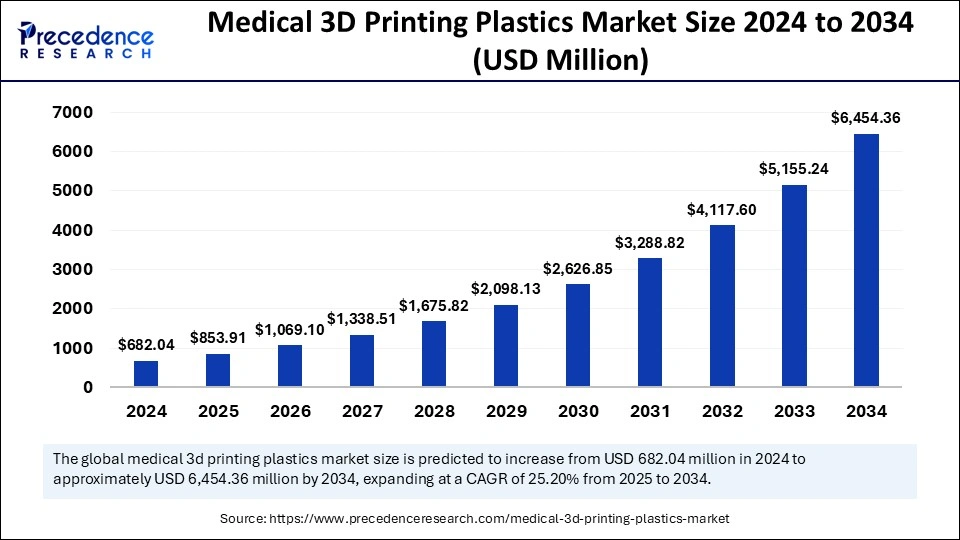
Medical 3D Printing Plastics Market Key Takeaways
- North America dominated the global market with the largest market share of 45% in 2024.
- Asia Pacific is projected to grow at a double digit CAGR of 26.3% during the forecast period.
- By type, the photopolymer segment held the major market share of 48% in 2024.
- By type, the PEEK segment is expected to grow at a solid CAGR of 26.2% between 2025 and 2034.
- By form, the filament segment accounted for a considerable market share of 77% in 2024.
- By form, the powder segment is predicted to grow at the highest CAGR of 25% during the studied years.
Medical 3D Printing Plastics Market Overview
The Medical 3D Printing Plastics Market has been experiencing robust growth as additive manufacturing continues to revolutionize the healthcare sector. This market encompasses the use of high-performance thermoplastics and resins in 3D printing applications, specifically for medical devices, prosthetics, surgical planning models, implants, and drug delivery systems. The growing demand for patient-specific treatment solutions, combined with the advancement of biocompatible and sterilizable materials, has driven widespread adoption of 3D printing technologies in medical practices.
Medical-grade polymers such as polylactic acid (PLA), polyether ether ketone (PEEK), and acrylonitrile butadiene styrene (ABS) are among the commonly used plastics in this space due to their strength, versatility, and compliance with healthcare safety standards. With ongoing innovations and regulatory support, the market is poised to expand further in both developed and emerging healthcare economies.
Medical 3D Printing Plastics Market Drivers
Several factors are propelling the growth of the medical 3D printing plastics market. One of the primary drivers is the increasing preference for customized healthcare solutions. 3D printing allows the production of personalized implants, prosthetics, and anatomical models tailored to individual patient anatomy, leading to better clinical outcomes and reduced surgery times. The rising incidence of chronic diseases and age-related conditions also contributes to the demand for precision medical devices, fueling the need for efficient and adaptable printing materials.
Technological advancements in 3D printing hardware and software, along with improvements in material science, are enabling faster, more accurate, and cost-effective manufacturing processes. Moreover, supportive government initiatives and funding for 3D printing research in healthcare are encouraging wider adoption across hospitals, research centers, and academic institutions.
Medical 3D Printing Plastics Market Opportunities
The medical 3D printing plastics market presents several exciting opportunities for innovation and expansion. There is significant potential in developing new biocompatible and biodegradable polymers that can meet the complex regulatory and clinical requirements of medical use. Emerging trends such as 3D-printed drug delivery systems and bioresorbable implants open up avenues for plastics manufacturers to explore novel formulations and material blends.
The integration of artificial intelligence and machine learning into 3D printing design and workflow optimization also offers a transformative edge in terms of precision and scalability. Furthermore, the adoption of 3D printing in remote and underserved areas for on-demand production of medical tools and devices represents an untapped market segment with considerable humanitarian and commercial potential.
Medical 3D Printing Plastics Market Challenges
Despite the promising outlook, the market faces several challenges that need to be addressed. Regulatory complexities and stringent approval processes for medical-grade 3D-printed devices can slow down product development and commercialization. Material limitations also persist, particularly in ensuring consistency, durability, and biocompatibility across a range of medical applications. High initial costs associated with setting up 3D printing infrastructure, along with a shortage of skilled professionals familiar with additive manufacturing in medical settings, may hinder adoption, especially among smaller healthcare providers.
Additionally, concerns related to intellectual property, reproducibility of results, and the lack of standardized protocols for 3D-printed medical products pose barriers to large-scale implementation.
Medical 3D Printing Plastics Market Regional Insights
North America holds a dominant position in the global medical 3D printing plastics market, largely due to the advanced healthcare infrastructure, significant R&D investments, and early adoption of cutting-edge technologies. The United States, in particular, has seen widespread integration of 3D printing in clinical settings, supported by strong regulatory frameworks and collaborations between academic institutions and industry leaders. Europe follows closely, driven by robust government support and a growing emphasis on personalized medicine.
Meanwhile, the Asia Pacific region is expected to exhibit the fastest growth over the forecast period, owing to rising healthcare expenditure, improving medical facilities, and increased awareness of 3D printing capabilities. Countries like China, Japan, and India are investing heavily in medical innovation, opening doors for expansion in this high-potential market.
Medical 3D Printing Plastics Market Recent Developments
In recent years, the medical 3D printing plastics market has seen several key developments that reflect its dynamic nature. Leading companies have introduced new grades of medical polymers with enhanced mechanical and thermal properties tailored for surgical guides and implantable devices. Partnerships between material manufacturers and healthcare technology firms have accelerated the development of end-to-end 3D printing solutions, enabling faster prototyping and clinical testing.
Regulatory bodies like the FDA have also taken steps to streamline approval processes for certain categories of 3D-printed medical devices, which has encouraged startups and innovators to enter the market. Additionally, the rise of cloud-based platforms for 3D design and remote printing services is helping to democratize access to high-quality medical manufacturing, particularly in resource-limited regions.
Medical 3D Printing Plastics Market Companies
- Victrex plc.
- Stratasys Ltd.
- Solvay
- SABIC
- Proclaim Health
- Evonik Industries AG
- ENVISIONTEC, INC.
- DSM
- Arkema
- Apium Additive Technologies GmbH
- 3D Systems, Inc.
Segments Covered in the Report
By Type
- Polylactic Acid
- Polyamide
- Photopolymer
- PETG
- PEEK
- ABS
By Form
- Filament
- Ink
- Powder
By Region
- North America
- Europe
- Asia Pacific
- Latin America
- Middle East and Africa